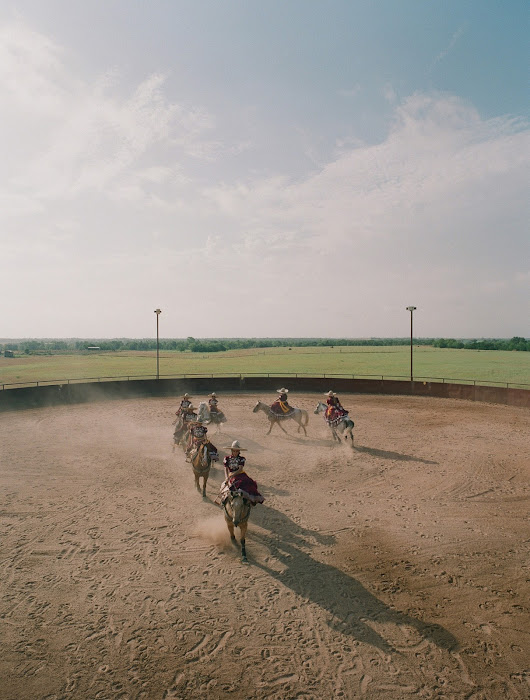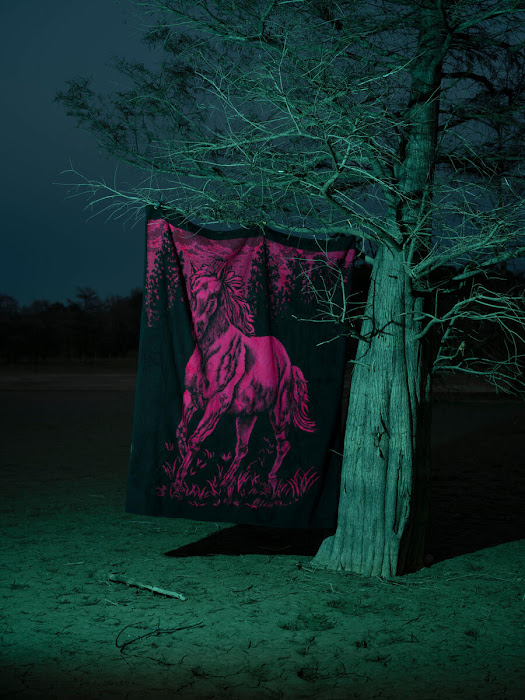"Historically Charrería, which is the national sport of Mexico, was predominantly male. Charrería emerged from early Mexican cattle ranching activities and was eventually refined and formalized during the post-revolutionary era as a romantic, nationalist expression of ‘lo mexicano’ (Mexicanness). It is similar in many ways to American rodeo in its variety of competitive equestrian activities. Women, however, were not seen participating on horseback until the 1950s when they were finally brought into the sport as riders.

A discipline was invented for female participants called ‘Escaramuza,’ consisting of all-female precision horse riding teams who execute exacting maneuvers while riding sidesaddle at high speed and wearing traditional Mexican attire. The costumes and synchronized patterns they perform were inspired by the Soldadera or Adelita, the women who fought in the Mexican Revolution between 1910-1920. To this day, the events within Charrería remain heavily gender segregated. A charreada lasts up to three hours but the portion dedicated to Escaramuza makes up for three to five minutes of those three hours, so there is still a large discrepancy between the representation of genders within the sport.
Escaramuza is wide-spread in Mexico of course, and becoming increasingly established in the United States as Charrería keeps growing. Initially, I was drawn to the visuals. The dresses are colorful and intricate, and the performance is elegant and powerful, like a ballet on horseback. But it is the stories of the women I met that really captivated me. The dedication that they have for the sport and their drive to uphold this tradition is admirable. In Mexico, Charrería tends to be a sport practiced by the wealthy, while many of the charros and charras in the US work hard to be able to afford the costs associated with owning and competing with horses. A lot of the women I met are full time students, or have full time jobs, sometimes multiple jobs and are raising children.

The sport is also dangerous. The women ride side saddle in heavy, hand-crafted dresses. A team consists of eight riders, and they perform patterns, criss-crossing each other at high speed. Riding side-saddle is extremely difficult as you only have good control over one side of the horse. There is a narrative around immigration and the role it plays in the development of the sport in the US, shaped by this feeling that many of the riders expressed to me of “not feeling Mexican enough when traveling to Mexico, but not feeling American enough at home either.”
Then there are the gender relations. Many riders expressed frustration regarding their inability to vote within the Charrería governing association, and the strictness of the dress rules they are subjected to, which is not the case for the disciplines practiced by the men. And finally, the parallels with the women who fought in the Mexican Revolution, the lack of historical research on their role, how they were remembered through time. Essentially, it felt like such a richly layered story, there was so much unpacking to do that I couldn’t look away.

The women I photographed are from all around the US. They are for the most part first, second, third, fourth and fifth generation Americans. As I got to know these women personally, I became aware of the importance of their oral histories. I needed to bring their voices back into the work somehow. I started interviewing teams as I went. I met teams from California, Texas, Washington, Illinois, Iowa and Colorado, recording their stories as I photographed them. I tried to understand how they thought of their position in Charrería, what Escaramuza meant to them and how they wanted to be seen, which influenced the way I photographed them. I am continuing the project as I expand the body of work for an upcoming book, and attempting to cover as many of the US states as possible.

Escaramuza translates to ‘skirmish’ in English, inspired by the image of the soldaderas sent into battle before the men to kick up dust and distract the opposing side. Women of course played a much more significant role than simple distraction during this complex and destructive civil war. They were activists in feminist movements, but a much larger number of women of rural and lower urban classes found themselves caught up in the struggle and had no choice but to be actively involved, whether it was as camp followers and caretakers for the soldiers, or as women who took up arms.

I see parallels between the soldaderas’ contribution to the advancement of women’s emancipation in Mexico and the Escaramuzas I met who are pushing back on the machismo in their sport. Especially for the US-based Escaramuzas growing up in blended cultures. The image of the soldadera is a powerful historical example and reference point. It means that Escaramuza is much more than a way to connect with contemporary Mexican traditions. It also connects these women to their history, the history of their people and of women in their culture. It gives women a certain image of strength to refer to.
One of the riders told me that she wanted to inspire other young women by showing them that they too could ride horses, be fierce and competitive and that they too could have a place in Charreria. Soldaderas provide evidence of women defying social expectations, and that has an impact.
(...) Escaramuza is an example of cultural preservation in an era where globalization often dilutes local traditions; a way of keeping customs and stories of past generations alive by passing down skills and technique from one generation to the next. It is a celebration of heritage. It is also a source of personal empowerment for many of the women involved, providing a strong sense of identity and pride and challenging traditional gender roles by showcasing women as skilled equestrians and leaders in their communities. This empowerment is not only personal but also communal, as it helps redefine gender norms within a cultural context."
Constance Jaeggi
- - - - - - - - -
photographs by Constance Jaeggi via and via and via








































































